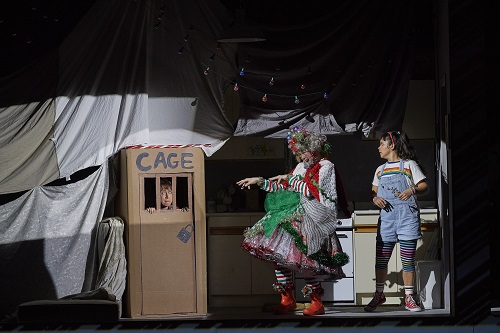
Stakes aren’t high enough in this modern take of Hansel and Gretel
I was curious as to how setting Hansel and Gretel set in 21st century Toronto, as opposed to the forests of 19th century Bavaria, would change the well-known Grimm brothers fairytale. The themes concerning food insecurity and parents struggling with poverty and addiction are certainly as timely here and now as they have always been.
Directing for Canadian Opera Company, Joel Ivany interprets the story with his signature outside-the-box creativity and makes impressive use of projection to create sets. However, in the interest of making the story more relatable to modern audiences, some of the dramatic tension that has made the fable compelling for centuries is sacrificed.
In Ivany’s retelling, the children live in a small high-rise unit with their working-poor parents. They are struggling to put food on the table and father drinks to cope with shame and anxiety. In an effort to escape the tensions at home and rustle up some dinner, they go on an extended pretend-play caper throughout their high-rise complex, with the participation of various eccentric neighbours they encounter during their nighttime wanderings.
It’s a fantastical story that could certainly unfold in any downtown apartment building. The children are cute and relatable. The plight of parents who cannot consistently feed their kids is one we know is happening in our city every day.
The production is fun to watch too. We get a sweeping projection of Toronto’s skyline during the overture that looks very majestic. The gingerbread house is rendered using dancing projections of gingerbread cookies and peppermint candies (S. Katy Tucker, Set and projection design).
Costume design (Ming Wong) is a big success of this production. A silver sequined Sandman and a gingerbread witch that looks like she’s off to read at a Christmas edition of Drag Queen Story Time.
The show is chock full of fun, campy moments. One of my favourites was Hansel and Gretel doing some dances that are popular with the elementary school set right now, such as “the floss” and “dabbing” when they decide to dance instead of doing chores during the opening scene.
19th-century German composer Engelbert Humberdink’s score is delightful. The charm and elegance with which the music mines German folk melodies is an exemplar within German romanticism. Hansel (Emily Fons) and Gretel (Simone Osborne) carry most of the show with significant support from The Father (Russell Braun) and The Mother (Krisztina Szabo), The Witch (Michael Colvin) and the sandman (Anna-Sophie Neher).
Osborne’s crisp, tartly sweet soprano and Fons’ rich, plummy mezzo-soprano blend and contrast beautifully. Together they navigate Humperdink’s high, intricately cheerful melodies with the soaring delight of a child’s fresh-faced joy. This is obviously a very fun sing for them, and they revel in stepping into a child’s body language and facial expressions on stage.
Russel Braun gives an excellent performance of The Father’s Act 1 aria, Ral La la la, which is one of the most sombre moments of the work. His warm, creamy baritone basks in the low minor melodies of this aria about hunger and poverty.
Tenor Michael Colvin gives a hilarious character-sing as the witch, rocking the glittering Christmas wrap drag queen number with ease.
The orchestra provides a precise and sensitive rendering of the score, rich with dynamic and dramatic contrast under the baton of Johannes Debus.
Despite the production’s many virtues, I was detached throughout the performance. Once it becomes clear that their experiences at the gingerbread house are make-believe, the story loses its antagonist. The children are never in any real danger, and the drama lacks urgency.
My reaction was akin to my reaction to playdates at my house that are going swimmingly. The rumble of children cheerfully building a blanket fort or repurposing a cardboard box fades into pleasant background noise. I crack on with housework or nice chit chat with the other parents, rousing myself only if the kids are having some sort of issue or creating destruction. There was just never any reason to rouse myself during this version of the story.
In the absence of any real threat from the witch, the final children’s chorus, while lovely, made no sense. In the original version, the witch has paralyzed countless children as gingerbread men, and they are magically reanimated at the opera’s close.
The Christmas theme was jarring, given that we are now well into February. Humperdink wrote the opera as a Christmas puppet show for his nieces and nephews, and it was typically performed at Christmastime during the 20th century. I question the necessity of adhering to the performance tradition of a Christmas theme if the work is being mounted months after the holiday season.
The music and singing are enchanting, and the staging is very easy on the eyes. While the drama fell flat for me, this would be a great choice for exposing kids to opera.
Details:
- Hansel and Gretel is playing until February 21, 2020 at Four Seasons Centre for the Performing Arts (145 Queen Street West)
- Showtimes are 7:30 PM on February 6, 11, 15, 19 & 21, with additional matinees at 2 PM on February 16, and 4:30 PM on February 8.
- Ticket prices range from $45 – $365. Patrons under 30 can purchase tickets for $22 or $35 here.
- Tickets are available online, or through the box office at 416-363-8231 (long distance 1-800-250-4653).
- Tickets can also be purchased on the TodayTix app and website for theatre tickets.
Photo of Emily Fons, Michael Colvin and Simone Osborne by Michael Cooper
